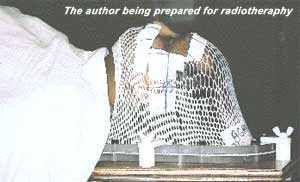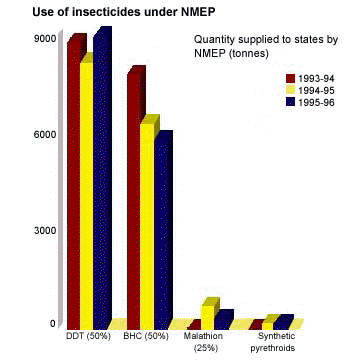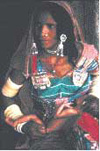Causes of NHL
It is impossible to pinpoint why a particular individual gets cancer. Carcinogenesis can
result from stress (which depresses the immune system), bad diets, environmental toxins
like pesticides, air pollutants and industrial chemicals, waste products and even genes.
While diet and stress are factors more associated with personal lifestyles, environmental
contamination is a societal problem and, therefore, needs greater attention and
regulation.Risk
of lymphatic cancers increases when the body’s immune system gets affected
In the US, where nhl incidence has increased by over 65 per
cent between 1973 and 1990 — the second fastest increase in cancer incidence
rates of all human cancers in the us in the last 15 years — there is considerable
effort to identify the causes and quantify their impact on the increase of nhl. Says
Sheila Hoar Zahm of the nci, “nhl is increasing not just in the us but in all
industrialised countries. Overall, we may be making gains in cancer, but because nhl
incidence is small compared to the mega-cancers, say breast cancer or lung cancer, figures
for the latter cancers tend to swamp the overall cancer statistics.”
 In India, the meagre data collected by ncrp for different cities shows a
steady increase. In Madras, there is literally a doubling of incidence in 10 years between
1982 and 1991 amongst both males and females, besides substantial increases in Mumbai and
Bangalore. While the database for Delhi and Bhopal is too small to identify any trend, the
statistics do show that Delhi has the highest incidence amongst both males and females
followed by Mumbai. Interestingly, a comparison (see: ‘Incidental comparisons’)
clearly shows that nhl incidence is rising faster than overall cancer incidence; in Mumbai
and Madras, the difference in increase is quite dramatic. However, in a conspiracy of
silence, almost all specialists at the Tata Cancer Memorial Centre in Mumbai interviewed
by Ambika Puri, a cse researcher, replied in the negative when asked if nhl was increasing
in India. In India, the meagre data collected by ncrp for different cities shows a
steady increase. In Madras, there is literally a doubling of incidence in 10 years between
1982 and 1991 amongst both males and females, besides substantial increases in Mumbai and
Bangalore. While the database for Delhi and Bhopal is too small to identify any trend, the
statistics do show that Delhi has the highest incidence amongst both males and females
followed by Mumbai. Interestingly, a comparison (see: ‘Incidental comparisons’)
clearly shows that nhl incidence is rising faster than overall cancer incidence; in Mumbai
and Madras, the difference in increase is quite dramatic. However, in a conspiracy of
silence, almost all specialists at the Tata Cancer Memorial Centre in Mumbai interviewed
by Ambika Puri, a cse researcher, replied in the negative when asked if nhl was increasing
in India.
The study says it
all
ICMR’s “withdrawn” research points to pesticides-cancer connection |
| When I first pointed out to friends in India
that scientific studies suggest exposure to pesticide residues as a strong cause of my
cancer, many of them wondered how could I — living the protected life of a middle
class Indian — have been exposed to pesticides. The findings of a seven-year study by
the Indian Council of Medical Research (ICMR) called Surveillance of Food Contaminants in
India, released in 1993, provides enough answers. Some 2,205 samples of cow and buffalo
milk, collected from 12 states, were studied. |
| Detectable residues of alpha, beta and gamma
isomers of HCH (or BHC, a highly poisonous pesticide) were found in 87, 85 and 85 per cent
of the samples. The percentage of samples exceeding the scientifically determined
tolerance limits were 21, 42 and 28 in the case of alpha-, beta- and gamma-HCH,
respectively. |
| The worst contamination was in the states of
Andhra Pradesh (AP), Bihar and Uttar Pradesh; dietary intake of beta-HCH was about twice
the acceptable daily intake (ADI) amongst populations with high incomes in urban areas of
AP. |
| DDT residues were detected in about 82 per cent
of the samples. About 37 per cent contained DDT residues above the tolerance limit of 0.05
mg/kg. The maximum level of DDT residues was found to be 44 times above the tolerance
limit — 2.2 mg/kg. |
| Maharashtra had 74 per cent samples with DDT
residues above the tolerance limit, Gujarat 70 per cent, AP 57 per cent, Himachal Pradesh
56 per cent and Punjab 51 per cent. |
| Industrial milk — infant formula, for
instance — also had pesticide residues. Out of some 186 samples of 20 commercial
brands of infant formula, 70 per cent showed DDT residues and 94 per cent revealed the
presence of HCH-isomers. The dietary intake of beta-HCH by an infant fed on infant formula
was 90 per cent of the ADI. |
| On its release, the report had claimed the
attention of the media and the Parliament. But in mid-1996, the ICMR refused to give this
author a copy of the study saying that it had been “withdrawn” and was being
“reconstituted” because “it had faults in its data and analysis”, and
that it would not be available until 1997. |
Cancer experts believe that risk of lymphatic cancers
including nhl increases when the body’s immune system gets affected or suppressed.
Says N K Mehrotra, head of the environmental carcinogenesis laboratory in the Industrial
Toxicology Research Centre (itrc), Lucknow, “The causes of lymphoma are as yet
unknown, but it mainly occurs due to cumulative effects of pollutants and reduced immunity
in the body.” A number of nhl cases in the us occur in people who have been affected
by hiv, the dreaded aids virus. In India too, the spread of hiv will definitely boost the
incidence of nhl. But the nci does not believe that the hiv virus, or cancer-causing
viruses like human t-cell leukaemia virus-1 or the Epstein-Barr virus, play an important
role in the increase of nhl. Neither do dietary factors, according to it.
Programmes for
ill-health
Indian public health programmes use toxic pesticides with impunity |
| Indian planners doggedly persist in using DDT
in their spraying programmes, though several nations have banned its use. Part of the
government’s obduracy is the result of the worst form of ‘state
capitalism’: the major manufacturer of DDT in India is a state-owned company called
the Hindustan Insecticides Ltd. |
| Even as late as 1995-96, some 9,000 tonnes (t)
of DDT were supplied to state governments by the National Malaria Eradication Programme
(NMEP). Though the government has begun phasing out the use of another dangerous
insecticide, BHC, 5,784 t of it were used in 1995-96. Use of alternatives like malathion
and synthetic pyrethroids, that began in 1969 and 1995-96 respectively, has remained
restricted because of high costs — which shows how little money the government is
prepared to spend on safe public health programmes. |
| Even though some excellent work has been done
by institutes like the Malaria Research Centre, New Delhi, and the Vector Control Research
Centre in Pondicherry on environmental control of disease-spreading insects, policy-making
and implementing agencies like the ministry of health and the NMEP have paid no attention. |
 The
nci says that certain immunosuppressive genetic syndromes can play a role in causing nhl,
but that they are too rare to bring about any major increase in cases. Similarly, 50-fold
increases in risk of nhl have been observed among organ transplant patients, because they
receive powerful immunosuppressive drugs on a long-term basis; but again, these conditions
affect very few people. A detailed statistical study in the us concludes that accuracy and
completeness of diagnosis, the impact of hiv and occupational exposures leave unexplained
an 80 per cent rise in incidence among white men. The nih study also argues that improved
diagnostic facilities and recent reclassification of other cancers into lymphomas account
for a tiny fraction of the increase in nhl. The
nci says that certain immunosuppressive genetic syndromes can play a role in causing nhl,
but that they are too rare to bring about any major increase in cases. Similarly, 50-fold
increases in risk of nhl have been observed among organ transplant patients, because they
receive powerful immunosuppressive drugs on a long-term basis; but again, these conditions
affect very few people. A detailed statistical study in the us concludes that accuracy and
completeness of diagnosis, the impact of hiv and occupational exposures leave unexplained
an 80 per cent rise in incidence among white men. The nih study also argues that improved
diagnostic facilities and recent reclassification of other cancers into lymphomas account
for a tiny fraction of the increase in nhl.
 The menace: pesticides The menace: pesticides
The key factor which is, therefore, attracting worldwide interest amongst epidemiologists
is environmental pollution. Several studies carried out in Canada, Sweden and the us have
shown a strong correlation between the risk of nhl and use of pesticides.
Frequent use of herbicides, particularly
2,4-dichlorophenoxyacetic acid (2,4-d) has been associated with a 200-800 per cent
(two-eight times) increased risk of nhl in Sweden. According to one study, the association
between nhl and phenoxy acid herbicides may be because of contamination by dioxin, a
highly poisonous immunosuppressant. The nci study argues that though the number of people
working in agriculture occupationally exposed to these and other pesticides is not large
enough to explain the overall increases in nhl, the general population is also at a
heightened risk because of the use of these pesticides in homes, lawns and golf courses.
Dogs whose owners have used 2,4-d, for instance, have a heightened risk of contracting
malignant lymphoma.
The reach: Is there anything at all that is uncontaminated by pesticides? |
 In human milk (Ahmedabad, Lucknow and
Chandigarh) In human milk (Ahmedabad, Lucknow and
Chandigarh)
|
 In drinking water (Lucknow) In drinking water (Lucknow) |
 In foodstuffs like pomfret fish (Mumbai) In foodstuffs like pomfret fish (Mumbai) |
 In crabs (Malnad) In crabs (Malnad)
|
 In eggs (Mumbai and Lucknow) In eggs (Mumbai and Lucknow) |
 n butter (Hissar, Chandigarh,Delhi, Lucknow,
Ludhiana, Pantnagar and Gujarat) n butter (Hissar, Chandigarh,Delhi, Lucknow,
Ludhiana, Pantnagar and Gujarat) |
 In foodgrains like wheat, rice and pulses
(Mumbai, Calcutta, Lucknow and Gujarat) In foodgrains like wheat, rice and pulses
(Mumbai, Calcutta, Lucknow and Gujarat) |
 In goat and buffalo meat (Lucknow) In goat and buffalo meat (Lucknow)
|
 In fruits and vegetables In fruits and vegetables
(Lucknow, Calcutta, Delhi, Ludhiana and Mysore) |
|
| In human adipose (fatty) tissue
(Ahmedabad, Calcutta, Delhi, Lucknow, Bangalore and Gujarat) |
| In human blood (Coimbatore, Delhi
and Jaipur) |
| In sheep meat (Jaipur and Srinagar) |
| In processed ghee (Lucknow) and
animal milk (Lucknow, Pantnagar and Ludhiana) |
| In infant milk preparations (Mumbai,
Chandigarh and Gujarat) |
| In animal fats and oils (Calcutta) |
| In condiments (Calcutta) |
| In vegetable oils (Delhi, Lucknow,
Sitapur and Gujarat) |
| In soils (Chikmagalur, Delhi and
Pantnagar) |
| In the air (Ahmedabad) |
|

